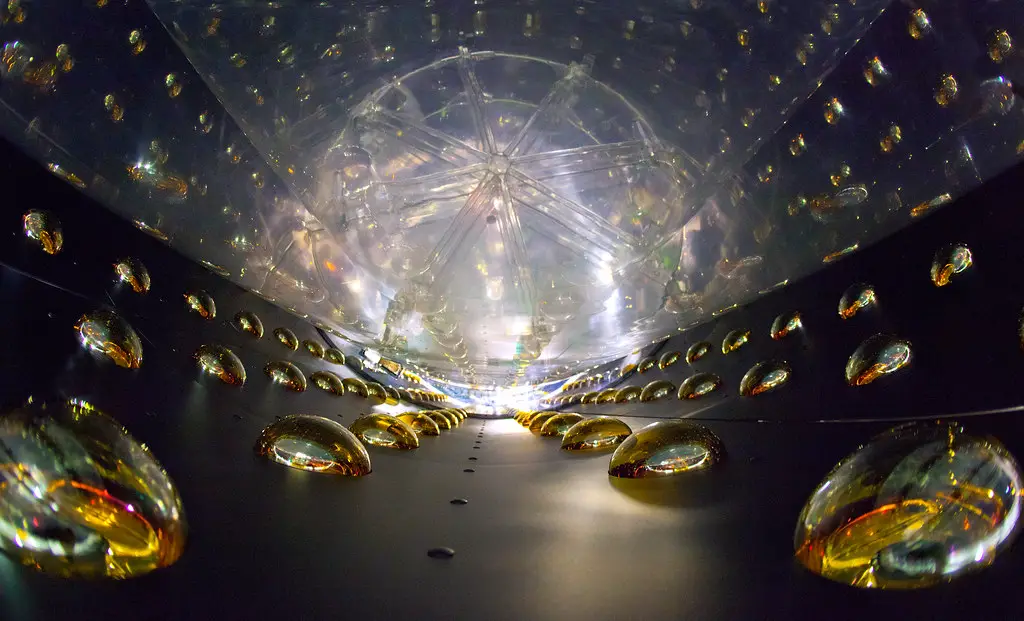Neutrinos are elementary subatomic particles with no charge and little or no mass. They participate in only the weak subatomic force and pass through almost unaffected ordinary matter. Neutrinos have no rest mass and travel at speeds close to the speed of light. Neutrinos oscillate between different flavors (electron, muon, or tau) by changing their flavor “mixing angle.” Neutrinos are tiny particles that interact with other matter only via weak subatomic force and gravity.
Wolfgang Pauli first postulated them in 1930 to provide a theoretical solution to a problem concerning the decay rate of radioactive beta decay. He was discovered in 1956 by Clyde Cowan and Frederick Reines (for which they received the 1995 Nobel Prize for Physics). Neutrinos have a one-half spin and belong to the fermion family of particles. The most recent research shows that neutrinos may have mass, albeit very small (about 0.1 eV/c2). Neutrinos are among the most abundant particles in the universe, second only to photons, which form light.
Historical background
Neutrinos are among the most abundant particles in existence. In fact, they’re so common that trillions of them pass through you every second—and yet they rarely interact with anything, making them difficult to detect. This may seem like a downside, but it actually makes neutrinos very useful for scientists studying everything from dark matter to supernovas. Scientists have been able to measure these elusive particles since 1956, when two American physicists detected them while working on an experiment involving nuclear reactors. Since then, scientists have used increasingly sophisticated technology to study neutrinos and learn more about their properties. For example, experiments conducted by CERN (the European Organization for Nuclear Research) in 2012 confirmed that neutrinos can change from one type to another as they travel through space.
How Are Neutrinos Formed?
Neutrinos are formed in three common ways:
- Cosmic rays hitting the upper atmosphere create neutrinos when they interact with atoms, as do nuclear reactions such as those inside stars and the Sun. Most of the neutrinos we detect on Earth are from the Sun; they are emitted during fusion reactions within its core.
- They are produced in high-energy collisions between cosmic rays and the Earth’s atmosphere or by cosmic ray interactions with the Earth’s surface. As these cosmic rays collide with atoms in the upper atmosphere or ground level, they produce a shower of secondary particles, which can then interact to create an extremely energetic neutrino.
- High-energy nuclear reactions within stars can create neutrinos. Neutrinos can travel through matter unimpeded, making them very difficult to study or detect. Some experiments send beams to detect the presence of neutrinos.
What Is Antineutrino?
Antineutrinos are produced as a byproduct of nuclear power generation. The antineutrino itself is not dangerous, but rather the neutrons emitted along with them. To detect these neutrons and prevent them from causing reactor damage, they must be captured in unique neutron-absorbing materials called neutron moderators (usually water), which slow down the neutrons to interact with other particles create more stable atoms.
Antineutrinos are subatomic particles with no electric charge and little to no mass. They are the antiparticles of neutrinos and were first predicted by Wolfgang Pauli in 1930 to preserve energy, momentum, and angular momentum in beta decay. Physicists detected antineutrino oscillations for the first time in 1983 at a reactor in Ohio, the U.S., which showed that they must have a non-zero mass.
Presence of Antineutrino
Neutrinos are one of the most present elementary particles in the universe. Their abundance exceeds W and Z bosons, but they still have escaped direct detection by experiments to date. They hardly interact with matter to travel through many light-years of material without a single collision.
Antineutrinos are neutral particles with a lepton number of 0 and spin ½. Wolfgang Pauli initially postulated antineutrinos in 1930 to preserve the law of energy conservation in radioactive beta decay, and they interact with other matter via weak interaction. Due to their property of being charge less, they can only be observed through the phenomena they initiate. For example, antineutrino interactions with protons produce positrons and neutrons.
![]()
